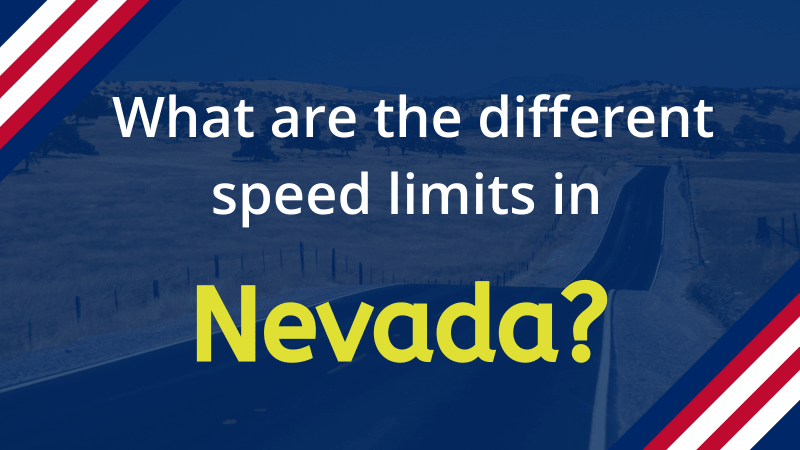Visiting Nevada for the first time? Maybe you are planning a move to the Silver State or have just relocated?
There is a lot to look forward to, including famous landmarks, natural attractions, shopping havens, Las Vegas in all its glory, and a buzz like no other city.
Yes, there is much to take in on a trip to Nevada or if you have just moved there, but one of the things that you absolutely need to be aware of is the Nevada speed limits – the various speeds you can travel on different roads in Nevada.
Knowledge of the different Nevada speed limits is especially important if you plan to do some driving, whether in the cities, on the highways, or in any of the rural communities. That is because speeding in Nevada, like most places in the U.S., can and most likely will attract hefty penalties and fines.
You can be slapped with a speeding ticket, for example, as well as have your license suspended due to an accumulation of points.

Knowing the correct Nevada speed limits is not only about avoiding punishment. It is also about driving safely on the roads to prevent accidents. Driving within the speed limit helps reduce the possibility of crashes and promotes efficient use of the road.
Traffic laws, including speed limits and other motor vehicle-related laws, are processed through and announced by the Nevada Department of Motor Vehicles. The different Nevada speed limits indicate the fastest speeds you are legally allowed to drive when the conditions are good – that is when driving in fair weather and with good visibility.
Of course, a specific Nevada speed limit does not necessarily mean you have to drive at that exact rate all the time. You still need to assess the road conditions and surrounding environment to determine the best speed at which to drive that is still within the prescribed speed limit.
Different speed limits are implemented based on several factors, including population density and type of road. For each community and highway, the speed limits are often posted on prominent signs along the roadway.
What is the Maximum Speed Limit in Nevada?
Traffic laws in Nevada define the maximum speed limit that any motorists traveling on Nevada roads can legally drive. However, driving above the signed speed limit within a specific road can result in a traffic citation, a fine/speeding ticket, license suspension, or even an arrest!
There is no trick on how the speed limit in Nevada works, what you see is what you get, literally! So, if you are driving through a residential area with a speed limit of 30 mph, you must drive at 30 mph or less and if you impede this, the likelihood is, you will be slapped with a fine and risk points being added to your record.
The Nevada speed limits include
- 15 mph in school zones, unless there is no school (holidays, etc.), half an hour after school ends, half an hour before school starts, if the school has a speed limit beacon and the lights aren’t flashing.
- 25 mph is the maximum speed limit for school crossing zones.
- 30 mph is the maximum speed limit in residential areas.
- 65 mph is the maximum speed limit on urban freeways.
- 70 mph is the maximum speed limit on divided roads.
- 70 mph is the maximum speed limit on undivided roads.
- 75 mph is Nevada’s highest speed limit and you can only drive at this speed on rural freeways.
When driving through residential areas, something to be aware of is schools, hospitals, and construction zones as these areas often have temporarily lowered speed limits and enforce these limits very strictly. You don’t want a hefty fine for not being aware of this!
Nevada Speed Limit Tickets and Points System
Nevada speed limit tickets and fines vary greatly, this is because the state itself consists of a few large cities, such as Las Vegas and Reno, however, there are many small towns with tiny populations in comparison, therefore the Nevada traffic fines and tickets do differ depending on where you are driving within the state.
Since there are discrepancies between the fines you receive within certain areas of Nevada, it is hard to gauge and there is no official ticketing and fining system. However, regardless of how fast you are going, the speeding ticket fines will range anywhere between $170-$230 with the addition of court fees, and insurance premium increases.
If you receive any speeding-related ticket in Nevada, you will have points added to your record too, and this time, there is more of a system put into place. It is pretty simple, the more you speed over the limit, the more points will be added to your record.
If you accumulate between 3 and 11 points within a calendar year, you will have to enroll in a Nevada DMV-licensed safety course. Attending and completing this course will wipe 3 points from your record.
Here are the number of points you will receive for specific speeding violations
- 1 – 10 mph over the speed limit is 1 point
- 11 – 20 mph over the speed limit is 2 points
- 21 – 30 MPH over the speed limit is 3 points
- 31 – 40 MPH over the speed limit is 4 points
- 41 mph or more over the speed limit is 5 points
- Driving too fast based on the conditions is 2 points
When visiting or relocating your family to Nevada, it is normal to have your mind focused on fun things to do. Knowledge of the Nevada speed limits – and adhering to them – will ensure your time is well spent and minimize the chance of you being fined or getting into an accident.


